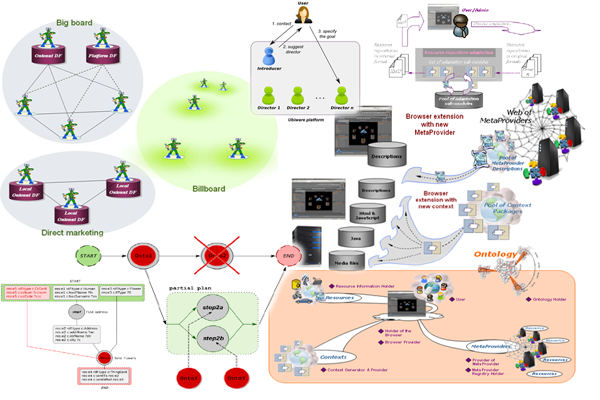|
Deliverable 3.1
Multi-resource orchestration in UBIWARE

UbiCore (Core UBIWARE Platform Design)
During WP1ís Year 3 (the Coordination phase), we will investigate the approaches where behavioral S-APL models are used not only as prescriptive tool (i.e. loaded by agent to act based on them), but also as descriptive tool - accessed by other agents to e.g. understand what to expect from or how to interact with the agent in question. WP1 will attempt to answer the following research questions:
How to enable agents to flexibly discover each other, based both on the roles played and on particular capabilities possessed.
What would be concrete benefits of and what mechanisms are needed for accessing and using a roleís script by agents who are not playing that role but wish to coordinate or interact with an agent that does?
The tasks of this workpackage will be merged with the WP2, the argumentation for such a confluence is given below.
UbiBlog (Managing Distributed Resource Histories)
During WP2ís Year 1 (the Sharing phase), needed mechanisms were designed for effective and efficient sharing of information between different agents, e.g. representing different resources. S-APL was used as the communication content language. During WP2ís Year 2 (the Integration phase), we have realized the possibility of querying a set of distributed, autonomous and semantically heterogeneous resource histories as they were one virtual database. We have introduced a new concept of Ontonuts and a corresponding technology. The Ontonuts where tailored to solve the problem of distributed querying in the first place. However, we have generalized the concept to the level of semantic capabilities, which allows us to use goal-based dynamic planning and execution of agentís actions. Therefore, the third year phase of the WP2 (Mining phase) as it was specified before would rather be an application case of the Ontonuts technology than a research topic. With respect to this fact we have decided to concentrate our efforts towards the fusion of the WP1 and WP2 3rd year objectives. Shortly, the WP1 objective for the 3rd year is to elaborate a mechanism for advertising of agent capabilities and role scripts (complex capabilities) amongst agents, whereas WP2 research targets data mining capabilities only. Therefore, it is reasonable to integrate WP1 and WP2 under one umbrella of Ontonuts technology which is targeting even more ambitious goal Ė to enable automated (re)planning and execution of semantically annotated agent actions including distributed data querying, data mining as well as distributed agent-to-agent servicing.
COIN (Self-Management, Configurability and Integration)
Self-management and configurability in UBIWARE can be seen from two points of view:
Initial self-configuration is understood as the ability of the system to interconnect and configure its components based on a certain goal or policy specified by the user. After specifying the goal of the system, the system itself should be able to automatically choose proper agents and delegate proper roles to them. The result should be a system that is performing the task specified by the goal. The user does not have to provide the system with any code, only the goal is needed. The system will find the best configuration based on the goal specified and a domain specific ontology.
Runtime self-configuration is the ability of the system to adapt to the environment. Thanks to this ability the system is able to perform its task even if the circumstances change. The process of runtime self-configuration should be context-aware, ontology-driven and policy-based.
Based on the text above, we specify the following research questions. First two are related to initial self-configuration and the third question is related to runtime self-configuration:
How can we find suitable agents to perform the task based on the goal specified by the user?
How can we transform a goal into a set of scripts to be executed by these agents?
Once the system is configured, how can we maintain this state even if the circumstances of the system change?
FOR EYE (Context-aware GUI for Integrated Data)
According to the last discussion during the steering group meeting, we agreed to concentrate 3rd year project research on business issues, commercialization steps of the results. Now when we have clear vision of the idea, have the elaborated prototype of an initial idea, we are ready for the next valuable step during WP5ís Year 3. This step will consist of two parts: elaboration of the general architecture of the product (necessary components, tools and utilization models) and commercialization part (business and market analysis, business models, promotion, distribution and etc.).
During WP5ís Year 3 (the Commercialization phase), therefore, the following research questions are to be answered:
What should be the general architecture of the product Ė 4I(FOR EYE) tool package so that it will be possible to build and further extend a different services based on the product? What are the requirements for the product, for the product components, what are the necessary modifications and the use cases of the product utilization?
What are the commercialization and marketing steps?
|
|
|

